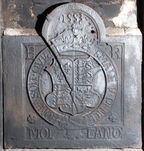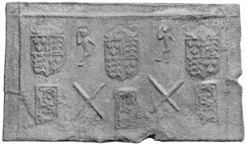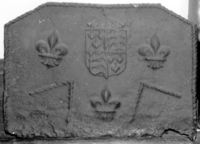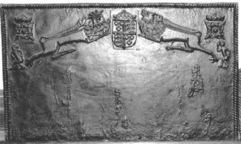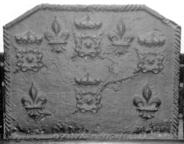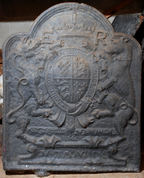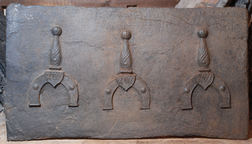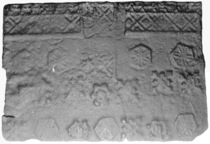-
1100
Description: Quasi-rectangular shape with inward curving sides; twisted rope edging (top and sides); arrangement of fleurs-de-lys: top centre, four in a star formation with two horizontally below; two vertically to left and right; vertical dagger, pommel to base, stamped twice inside outer fleurs.
Notes: A uniquely shaped fireback with fleurs and daggers (each about 35cm long) seen on two other firebacks (no. 595 and no. 660).
- Decoration tags:
- rectangular (shape)
- rope (edging)
- simple stamps
- carved stamps
- heraldic
- objects
Manufactured: in the mid-16th century in the Weald area of England.
Current location: Sackville College, Church Lane, East Grinstead, West Sussex, England.
- Attached to series:
- Royal series
- Knife & Dagger stamp firebacks
- Fleur-de-lys firebacks
-
288
Description: Arched rectangular with plain edges; arched rectangular inset with cavetto edging and armorial design in low relief: circular garter enclosing an ornate Tudor royal shield, surmounted by a crown; date inside top of arch; initials inside top corners of rectangle; a rose in each bottom corner of rectangle; inscription in a separate rectangular panel below, split by garter buckle.
Notes: The earliest dated fireback in the English style. Molland was a Devon manor belonging to the Courtenay family. Noted as having been at Wells Deanery, Somerset, in 1845; a variant without the motto, the existence of which was noted in 1840, was illustrated by Llewellin (1863). The west country source for both of these firebacks offers the possibility of an origin in those parts.
Copies of this fireback are known.
Inscription: 1553 / E R / HONV SOIT QVY MALE V PENCE / MOL LAND
Arms: Tudor royal - Edward VI
- Decoration tags:
- rectangular with round arch (shape)
- none (edging)
- whole carved pattern
- armorial
- royal
- text
Manufactured: in 1553 .
Current location: Davington Priory, Priory Road, Faversham, Kent, England.
Citation: Collier, C. V., 1897, 'Coats of Arms in Kent Churches', Archaeologia Cantiana, 22, pp. 190-1.
- Attached to series:
- Edwardian royal armorial firebacks
- Tudor royal armorial firebacks
-
67
Description: Pediment and frieze resting on fluted Tuscan pilasters; plain podium base; rectangular central panel with double fillet edge divided into four with central panel containing initials; date in tympanum; narrow rectangular panels on each side from base to cornice.
Notes: An early example of the use of classical architectural elements in an English fireback.
Inscription: 1568 / ER
- Decoration tags:
- rectangular with pediment (shape)
- none (edging)
- whole carved pattern
- individual letters
- extension panels
- architectural
- text
Manufactured: in 1568 in the Weald area of England.
Current location: in private hands, Frant, East Sussex, England.
- Attached to series:
- 1568 Architectural series
-
301
Description: Rectangular; inset twisted rope edging (top and sides); crowned Tudor royal shield stamp repeated three times across top, each pair interspersed with an 'imp' figure with right arm raised; below each shield, rectangular stamp with indistinct ?rose design, each pair interspersed with a twisted rope saltire.
Notes: The crowned shield and 'imp' figure associate this fireback with others of the Royal series; the saltires may have apotropaic significance. Illustration from Starkie Gardner 1898, p. 143.
Arms: Tudor royal arms of England
- Decoration tags:
- rectangular (shape)
- none (edging)
- simple stamps
- carved stamps
- heraldic
- apotropaic
- armorial
- royal
- humans
- objects
Manufactured: in the mid-16th century in the Weald area of England.
Current location: Stone House, Rushlake Green, Warbleton, East Sussex, England.
Citation: Gardner, J. S., 1898, 'Iron Casting in the Weald', Archaeologia, 56, 1, pp. 133-164.
- Attached to series:
- Royal series
-
124
Description: Canted rectangle; twisted rope edging (top and sides); top centre, crowned Tudor royal shield; fleur de lys on each side and below; slanting, inverted 'V' of twisted rope on each side of lower fleur.
Notes: One of a large series of firebacks incorporating Tudor heraldic stamps; the 'V' shapes may have apotropaic significance.
Arms: Tudor royal arms of England
- Decoration tags:
- rectangular with canted top corners (shape)
- rope (edging)
- simple stamps
- carved stamps
- heraldic
- apotropaic
- armorial
- objects
Manufactured: in the mid-16th century in the Weald area of England.
Current location: Hastings Museum and Art Gallery, John's Place, Bohemia Road, Hastings, East Sussex, England.
Museum number: HASMG: 1904.32 (part of the Hastings Museum museum group)
- Attached to series:
- Royal series
- Fleur-de-lys firebacks
-
127
Description: Rectangular; twisted rope edging (top and sides); top centre, crowned Tudor royal shield between a lion passant on the right and a lion passant guardant sinister on the left; in each top corner a crowned four-petal rose, below which, to the right, a left-facing 'imp' with right arm raised, and to the left, a left-facing 'imp' with both arms lowered.
Notes: One of a large series bearing heraldic stamps.
Arms: Tudor royal arms of England
- Decoration tags:
- rectangular (shape)
- rope (edging)
- carved stamps
- heraldic
- armorial
- animals
- humans
Manufactured: in the mid-16th century in the Weald area of England.
Current location: Hastings Museum and Art Gallery, John's Place, Bohemia Road, Hastings, East Sussex, England.
Museum number: HASMG: 1925.3 (part of the Hastings Museum museum group)
- Attached to series:
- Royal series
-
128
Description: Canted rectangle; twisted rope edging (top and sides), with dowel across the top corners; symmetrical arrangement of four crowned four-petal roses, top centre, bottom centre and both top corners; symmetrical arrangement of four fleurs de lys, two either side of top central rose, two in bottom corners.
Notes: One of a large series bearing heraldic stamps. Given to Hastings Museum by Mr A. E. Anderson of Brightling Hall, Robertsbridge, Sussex.
- Decoration tags:
- rectangular with canted top corners (shape)
- rope (edging)
- carved stamps
- heraldic
Manufactured: in the mid-16th century in the Weald area of England.
Current location: Hastings Museum and Art Gallery, John's Place, Bohemia Road, Hastings, East Sussex, England.
Museum number: HASMG: 1914.64.1 (part of the Hastings Museum museum group)
Citation: Butterfield, W. R., 16 Feb 1935, 'A Tudor Fireback', Hastings and St Leonards Observer.
Citation: Baines, J. M., 1958, Wealden Firebacks (Hastings Museum).
- Attached to series:
- Royal series
-
147
Description: Arched rectangular shape with rounded corners; ovolo within fillet moulding all round; oval Tudor royal shield with garter surrounding, topped with a royal crown; dragon and greyhound supporters; initials split by crown; inscription on a fillet between legs of supporters, behind garter finial; motto on an Ionic plinth at bottom.
Notes: The supporters are those of Henry VII or Henry VIII, but the initials suggest the fireback dates from the reign of Edward VI (1547-53). John Harvo (d. c1565) was a gunfounder who has been identified as occupying Pounsley furnace, Framfield, Sussex, possibly from as early as 1547. This fireback is also seen with a variety of rectangular, rope-edged side panels bearing stamps or letters, some of which link the source of this and other groups of firebacks. The pattern or model for this fireback may have been made during the reign of Henry VIII (1509-47), with the initials added to an early casting using the original pattern. The protuberance on the bottom of the plate may be the remains of the runner from a pouring basin or overflow channel used during casting. Formerly part of the Ade Collection (from Grove Hill, Hellingly, Sussex).
Copies of this fireback are known.
Inscription: E R / HONY SOYT QVE MAL Y PAVNCE / Made in Sussex by John Harvo / DV ET MOVN DRO
Arms: Tudor royal (Edward VI)
- Decoration tags:
- rectangular with round arch (shape)
- fillet and cavetto (edging)
- whole carved pattern
- individual letters
- armorial
- text
Manufactured: in the mid-16th century probably at Pounsley Furnace, Framfield in the Weald area of England.
Current location: Hastings Museum and Art Gallery, John's Place, Bohemia Road, Hastings, East Sussex, England.
Museum number: HASMG: 1952.51.52 (part of the Hastings Museum museum group)
Citation: Butterfield, W. R., 1916, 'Old Wealden Firebacks', The Connoisseur, 46, pp. 197-209.
-
166
Description: Rectangular; plain plate with three stamps of an iron firedog with a twisted design on the neck, a primitive face on the terminal and a shield bearing initials RW.
Notes: The letters RW are said to relate to Richard Woodman, ironmaster and Protestant martyr, who resided at Cralle Place, and who operated Cralle furnace. A near-identical firedog was discovered at Bridge Cottage, Uckfield, Sussex.
Inscription: RW
- Decoration tags:
- rectangular (shape)
- none (edging)
- simple stamps
- objects
Manufactured: in the mid-16th century probably at Cralle Furnace, Warbleton in the Weald area of England.
Current location: Hastings Museum and Art Gallery, John's Place, Bohemia Road, Hastings, East Sussex, England.
Museum number: HASMG: 1909.94 (part of the Hastings Museum museum group)
Citation: Butterfield, W. R., 1916, 'Old Wealden Firebacks', The Connoisseur, 46, pp. 197-209.
- Attached to series:
- Firedog stamp firebacks
- Metalware stamp firebacks
-
152
Description: Rectangular; plain plate; on top, twice repeated stamp probably formed of a section of cresting with a row of seven ?fleurs-de-lys above a diagonal grid of squares, each with a small raised square in the middle, and a horizontal astragal border below; between the cresting, a stamp of indeterminate form and design; below, four repeated hexagonal stamps, each divided into triangles by raised lines, two under each cresting stamp; between them, a stamp of indeterminate form and design, possibly the same as the one above it; below, probably six double crosses flory, with a flower head stamp between each group of three; along the bottom, two crosses flory, three hexagon stamps and two other stamps of indeterminate form and design (though different from those described above), arranged asymetrically.
Notes: A crude and poorly executed casting. Butterfield (1916) illustrated this fireback the other way up, and that is how it was displayed in Hastings Museum when it was photographed in the early 2000s. The orientation of this fireback has been reconsidered and the greater relative wear and heat corrosion of the smaller individual stamps suggests that the cresting was originally at the top of the fireback and not the bottom.
- Decoration tags:
- rectangular (shape)
- none (edging)
- carved stamps
- objects
Manufactured: in the mid-16th century in the Weald area of England.
Current location: Hastings Museum and Art Gallery, John's Place, Bohemia Road, Hastings, East Sussex, England.
Museum number: HASMG: 1911.60.8 (part of the Hastings Museum museum group)
Citation: Butterfield, W. R., 1916, 'Old Wealden Firebacks', The Connoisseur, 46, pp. 197-209.
- Attached to series:
- Miscellaneous stamp firebacks
.jpg)
